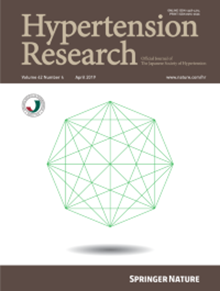依沙塞隆与三氯甲肼对未控制高血压的家庭降压效果:一项按年龄分组的EXCITE-HT随机对照研究的预先指定亚分析
IF 4.3
2区 医学
Q1 PERIPHERAL VASCULAR DISEASE
引用次数: 0
摘要
这项预先确定的多中心、随机、开放标签、平行组的EXCITE-HT研究的亚分析旨在确定依沙塞隆和三氯甲基嗪的相对疗效和安全性是否随年龄而不同。患者分为两个年龄亚组(65岁和≥65岁)。根据收缩压/舒张压(SBP/DBP)变化差异的双侧95%置信区间(CI)上限评估艾塞酮对三氯甲肼的非劣效性。如果该值为<;3.9/ < 2.1 mmHg,则认为依沙酮非劣药;如果血压为0毫米汞柱,则认为艾萨克酮的降压效果更好。结果显示,65岁亚组患者从基线到治疗结束(主要终点)早上家中收缩压/舒张压的最小二乘平均变化为艾塞酮组为- 9.5/ - 5.7,三氯噻嗪组为- 8.2/ - 4.9 mmHg(组间差异:- 1.3 [95% CI, - 3.3, 0.8]/ - 0.8 [- 2.1, 0.5] mmHg)。在年龄≥65岁的亚组中,这些变化为- 14.6/ - 7.2和- 11.5/ - 6.7 (- 3.0 [- 4.9,- 1.2]/ - 0.5 [- 1.5,0.5]mmHg)。65岁和≥65岁依沙塞隆治疗组血清钾水平≥5.5 mEq/L的发生率分别为2.2%和1.9%。综上所述,与三氯甲肼相比,依沙酮在降低血压方面达到了预定的非劣效边界。在65岁的患者中,艾塞酮在降低收缩压和舒张压方面达到了三氯甲肼的非劣效边界。在年龄≥65岁的患者中,艾塞酮在降低收缩压方面优于三氯噻嗪,在降低舒张压方面达到了三氯噻嗪的非劣效边界。依沙塞隆对血清钾水平的影响没有显示出特定的与年龄相关的影响。根据年龄(65岁和≥65岁)对EXCITE-HT研究进行的亚组分析显示,无论年龄如何,艾塞酮的降血压效果都达到了预定的三氯甲肼的非劣效边界。在年龄≥65岁的患者中,艾塞酮在降低收缩压方面优于三氯甲肼。本文章由计算机程序翻译,如有差异,请以英文原文为准。

Home blood pressure-lowering effect of esaxerenone vs trichlormethiazide for uncontrolled hypertension: a prespecified subanalysis of the EXCITE-HT randomized controlled study by age subgroup
This predefined subanalysis of the multicenter, randomized, open-label, parallel-group EXCITE-HT study aimed to determine whether the comparative efficacy and safety of esaxerenone and trichlormethiazide differs with age. Patients were divided into two age subgroups (<65 and ≥65 years). The non-inferiority of esaxerenone to trichlormethiazide was assessed based on the upper limit of the two-sided 95% confidence interval (CI) for the difference in systolic/diastolic blood pressure (SBP/DBP) changes. Esaxerenone was considered non-inferior if this value was <3.9/ < 2.1 mmHg; if it was <0 mmHg, esaxerenone was considered superior in its BP-lowering effect. The results showed that the least squares mean changes in morning home SBP/DBP from baseline to the end of treatment (primary endpoint) were −9.5/−5.7 with esaxerenone and −8.2/−4.9 mmHg with trichloromethiazide (between-group difference: −1.3 [95% CI, −3.3, 0.8]/−0.8 [ − 2.1, 0.5] mmHg) in the subgroup aged <65 years. These changes were −14.6/−7.2 and −11.5/−6.7 (−3.0 [−4.9, −1.2]/−0.5 [−1.5, 0.5] mmHg) in the subgroup aged ≥65 years. The incidences of serum potassium level ≥5.5 mEq/L were 2.2% and 1.9% in the esaxerenone-treated subgroups aged <65 and ≥65 years, respectively. In conclusion, esaxerenone achieved the pre-defined non-inferiority margin to trichlormethiazide in its BP-lowering effect regardless of age. In patients aged <65 years, esaxerenone achieved the non-inferiority margin to trichlormethiazide in lowering both SBP and DBP. In patients aged ≥65 years, esaxerenone was superior to trichlormethiazide in lowering SBP and achieved the non-inferiority margin to trichlormethiazide in lowering DBP. The impact of esaxerenone on serum potassium levels did not show a specific age-related effect. A subgroup analysis of the EXCITE-HT study according to age (<65 and ≥65 years) showed that esaxerenone achieved the pre-defined non-inferiority margin to trichlormethiazide in its BP-lowering effect regardless of age. In patients aged ≥65 years, esaxerenone achieved the superiority margin to trichlormethiazide in lowering SBP.
求助全文
通过发布文献求助,成功后即可免费获取论文全文。
去求助
来源期刊

Hypertension Research
医学-外周血管病
CiteScore
7.40
自引率
16.70%
发文量
249
审稿时长
3-8 weeks
期刊介绍:
Hypertension Research is the official publication of the Japanese Society of Hypertension. The journal publishes papers reporting original clinical and experimental research that contribute to the advancement of knowledge in the field of hypertension and related cardiovascular diseases. The journal publishes Review Articles, Articles, Correspondence and Comments.
 求助内容:
求助内容: 应助结果提醒方式:
应助结果提醒方式:


